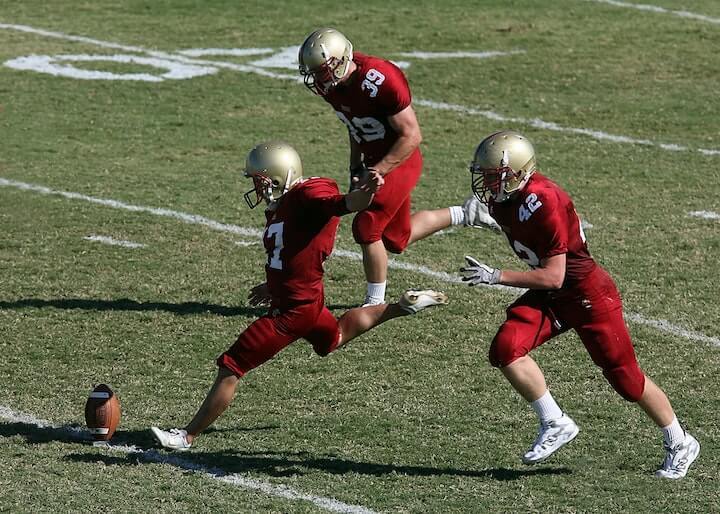Kickers aren't often considered one of the most important players on a team.
That is, of course, until they become the brunt of the blame for missing a key field goal... or until the entire team rushes the field to celebrate after the kicker makes a game-winning kick as time expires.
Kicking is an extremely important part of football that is often overlooked by the everyday fan.
Football coaches know just how important having a good kicking game is, though, which is why an entire coach is dedicated just to helping the kickers get better.
In addition to handling kickoffs, extra points, and sometimes even punts, a place kickers' main job is to convert field goal attempts.
Worth three points in football, a field goal is successful when the ball is kicked in between the two uprights on the goal post.
The ball can hit any of the posts or crossbar and still be good as long as the ball ends up going over the crossbar and in between the two uprights in the end.
While field goals are often seen as a consolation to offenses, racking up points is important no matter how you do it.
Sure, offenses would love to score a touchdown on every possession, but that's just not possible.
When they come up short on fourth down, being able to be in range to attempt a field goal is key, too.
While learning how to kick a field goal looks to be a pretty simple task, there's a lot of skill and technique that goes into it.
A kicker can't just have a strong leg if he wants to be a consistently good place kicker in football.
He needs to learn how to kick a football, how to have great timing with the long snapper and holder, and how to adjust his kicks for the weather conditions and the placement of the ball on the field.
If you want to learn how to kick a field goal in football so that you are converting every time, follow these 7 steps.
How to Kick a Field Goal
Step #1: Get Aligned Correctly
Before you can even attempt to kick a field goal, you have to make sure you are lined up properly.
If you don't do so, you won't be in a great position to be able to convert your field goal attempts at a high rate.
There isn't a set position that every kicker has to take.
Generally speaking, though, most kickers will position themselves roughly three paces behind the holder and roughly two steps to the side of the ball.
Right-footed kickers will, therefore, be two steps to the left, and vice versa for left-footed kickers.
This positioning will give you enough time and momentum to step into the kick properly, which will be extremely important in gaining enough power and accuracy on your kicks, as we'll soon see.
Work on what feels best for you in terms of positioning.
You can try all different combinations of steps back and to the side of the ball.
Just make sure that once you settle on a positioning, that you stay consistent with it and do it every time you attempt a kick.
Step #2: Stand Ready for the Kick
Once you have found your proper positioning behind and to the side of the ball, you should get in your proper stance.
You should bend your knees slightly, and rest on the balls of your feet.
Make sure that you center your body weight out over your hips.
Your off-foot (the one you won't be kicking with) should be placed slightly in front of the foot you will use to kick the ball.
This foot is also called your plant foot, as it is the foot you'll plant right next to the football while you are kicking.
Your kicking foot, then, will be slightly behind that plant foot.
Point the toes on both of your feet in the same direction as where they'll be when you make contact with the football.
Step #3: Set the Football Up Correctly
The second step when learning how to kick a field goal actually has nothing to do with the kicker at all.
In order for the place kicker to be given the best chance to succeed, the football must be set up correctly for him on the ground.
That's the job of both the snapper and the holder.
The long snapper must be able to get the ball back to the holder with force and accurately, and the holder must be able to catch the ball cleanly, put it down on the ground and rotate it properly before the kicker makes contact with the ball.
The holder needs to put the football perpendicular to the ground. The holder should tilt the ball slightly toward him, but keep it mostly straight upright.
Once the tip of the ball is on the ground, the holder needs to rotate it so that the laces are facing away from the kicker.
This gives the kicker the biggest area of the football to kick on, which allows the kicker to get maximum compression on the ball, which is important for power.
Kicking away from the laces will also allow the ball to be kicked higher.
Step #4: Approach the Football
This part will again vary slightly from kicker to kicker, depending on where he aligns himself and how long his legs are, for example.
Most kickers will take either two or three "approach steps" before making contact with the football.
Again, it doesn't matter so much how many approach steps you take, only that you're consistent with each attempt.
There are three "steps" that you will take in your approach steps.
Jab Step: This is the optional step. It's a short step in the same direction of the football that you'll take with the plant foot. It shifts body weight in the direction of the football.
Drive Step: This one is a long stride you'll take in the same direction toward the football. You'll take this step with your kicking leg.
Plant Step: This is taken by your plant foot, and it positions your foot next to the football. Once your plant foot is in the proper position, you'll be anchored in and ready to explode through the ball with your kicking foot.
As you'll notice when you attempt a field goal, you'll be taking a diagonal path to the football. This is a good thing.
When you're making that final step, put your plant foot about four inches back behind the football.
This will give you enough room to kick through the ball with the power you need.
Step #5: Keep Your Body Square
As you're approaching the football, make sure that your body is square to the goal posts.
This is especially important for your shoulders and torso, as it'll determine the accuracy of your kicks.
This will be a little tricky to master at first, since you'll be taking a diagonal path to the ball, but make sure to get it down.
Step #6: Kick the Ball
We're finally at the point where you'll be making contact with the football.
When you go to kick the ball, you'll want to aim at what's called the "sweet spot" of the ball. On a football, that's roughly four inches up from the bottom tip.
If you kick it higher, the ball won't travel as high.
If you kick it lower, it'll travel higher.
This will allow you to manipulate the ball depending on the distance of your attempt.
When making contact with the ball, make sure to kick it with the top of your foot.
Most kickers in football will use a soccer style.
In this style, you'll swing your leg to the other side of the ball after you make contact with it. Your foot will be angled at an obtuse angle.
With a straight kick, meanwhile, you'll keep your ankles locked when you kick it.
Again, there is no one better way than the other.
Try them out for yourself and see which one feels better and gives you the better results.

Step #7: Follow Through
After you make contact with the ball, it's important to follow through -- just as it is when you're throwing a football.
Don’t stop your motion once you've made contact. Instead, continue your kicking motion all the way through.
As you finish your follow-through, hop slightly forward on your plant foot.
In most cases, this is not something you'll have to think about doing. It will happen naturally as your momentum is going forward and your body balances itself.
One final note:
To get more power on a kick, you don't need to try to kick harder with your kicking leg.
The power you get from your kicks will come from the momentum you generate from your kicking leg and from your plant leg.
Conclusion
Learning how to kick a field goal may look easy, but it's a skill that takes time to master.
There are some crucial steps you need to take in order to learn the proper technique of kicking a field goal.
These techniques are all very simple, but they are very important to master how they are laid out above.
Practice them over and over so you can get a feel for what's right for you.
Then, you'll be kicking successful field goals over and over again.

